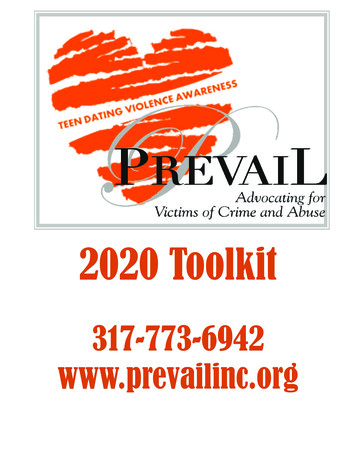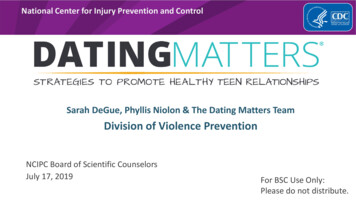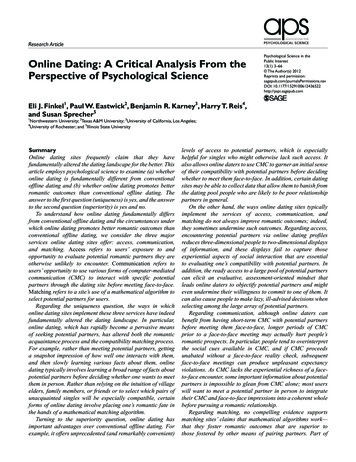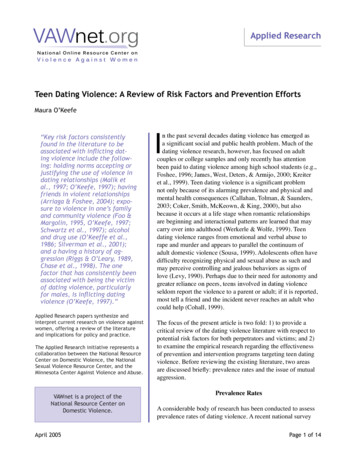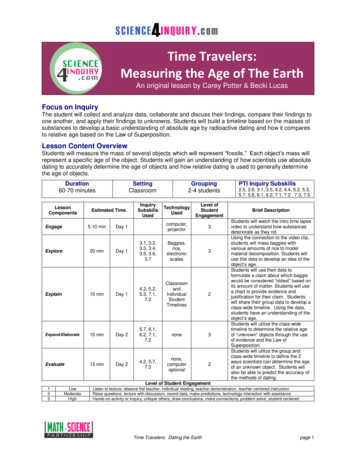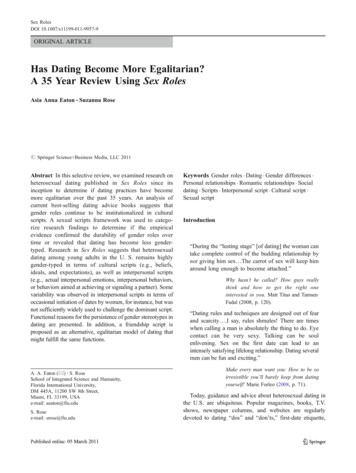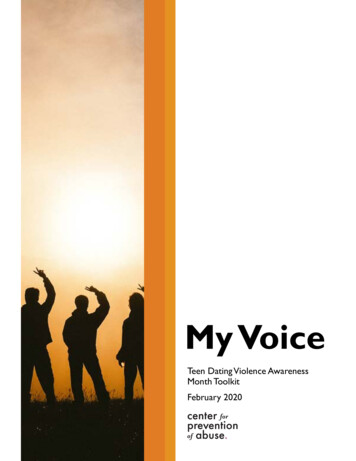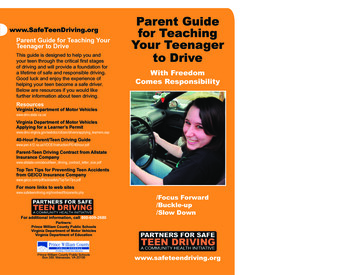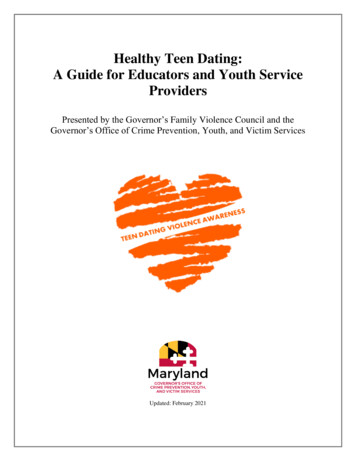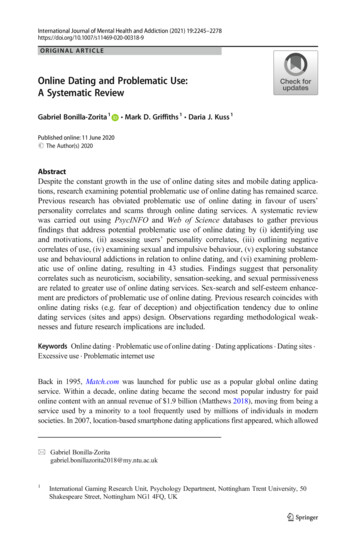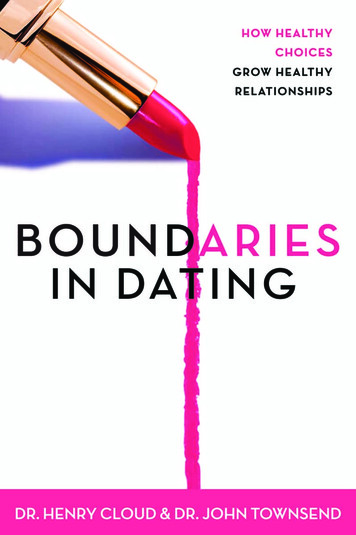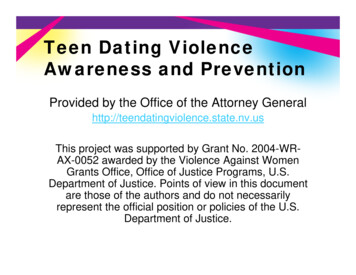
Transcription
Teen Dating ViolenceAwareness and PreventionProvided by the Office of the Attorney Generalhttp://teendatingviolence.state.nv.usThis project was supported by Grant No. 2004-WRAX-0052 awarded by the Violence Against WomenGrants Office, Office of Justice Programs, U.S.Department of Justice. Points of view in this documentare those of the authors and do not necessarilyrepresent the official position or policies of the U.S.Department of Justice.
Special Requests Mutual respect during class Interaction and questionsencouraged throughout Disclaimer on male vs.female violence Handouts
What is Teen Dating Violence? A pattern of physically, sexually, verbally, and/oremotionally abusive behavior in a datingrelationship. Dating violence takes many forms.It ranges from:punching, slapping, pushing, grabbingrape and murderthreats of violence, verbal attacks, and otherforms of intimidationextreme jealousy, possessiveness andcontrolling behavior
What is Dating Violencecontinued A pattern of abusive behaviors that overtime causes harm and/or fear. Use of emotional manipulation and/orphysical domination to gain control andpower over his or her partner. Does not discriminate. It affects people ofall races, religions, cultures, classes, samesex as well as heterosexual relationships.
Healthy RelationshipsA healthy relationship is based on equalityand mutual respect. Each partner’s growthand wellbeing is nurtured in an environmentof personal safety and emotional support.Power in a healthy relationship is balanced.While there may be conflict, there is no fear,no threats, and no violence. Healthypartners actively respect each other’s rights.
Abusive Relationships An abusive relationship is characterized byan imbalance of power that is maintainedthrough intimidation, coercion andviolence. The victim loses self-confidenceand supportive relationships with friendsand family members. Physical and sexual assaults, occur evenif infrequently, to keep the victim fearful ofmore violence.
Roles in an Abusive Relationship Abuser: A person who physically,sexually, verbally, or emotionally hurtstheir intimate partner. Target: A person who is hurt physically,sexually, verbally, or emotionally by theirintimate partner. Bystander: A person who is aware thatsomeone is being abused in a datingrelationship. A witness to the abuse.
Types of Abuse Physical Abuse – any intentionalunwanted contact with the other person’sbody. Physical abuse does not have toleave a mark or bruise. Examples: Scratching, Kicking, Biting,Pulling hair, Pinching, Burning, Strangling,Pushing, Shoving, Slapping, Using aWeapon, Hitting, and Spitting.
Types of Abuse - continued Sexual Abuse – any sexual behavior thatis unwanted or interferes with the otherperson’s right to say “no” to sexualadvances. Examples: Unwanted kissing or touching,Forcing someone to go further than he orshe wants, Unwanted rough or violentsexual activity, Not letting someone usebirth control or protection against sexuallytransmitted diseases.
Types of Abuse - continued Verbal/Emotional Abuse – Saying or doingsomething to the other person that causes theperson to be afraid, lower their opinion ofthemselves, or manipulating/controlling theperson’s feelings or behaviors. Examples: Name-calling and put-downs,Insulting the person/family/friends, Yelling andscreaming, Threatening violence or harm,Making racial slurs, Embarrassing the person,Spreading rumors about the person, Telling theperson what to do, Preventing the person fromseeing or talking to friends and family.
Verbal/Emotional Abuse - continued Making the person feel responsible for theviolence/abuse, Stalking the person,Harming or threatening to harm theperson’s pets. Making the person feel guilty about leavingthe relationship, Threatening to commitsuicide, Threatening to expose personalinformation about the person, Threateningfamily or friends.
Cycle of Violence – Phase 1 Tension Building - Things start to get tensebetween the two people. In this phase: There is arguing a lot, the abuser yells at thetarget for no reason The abuser may make false accusations aboutthe target, The target feels he or she can’t do anythingright, the atmosphere is tense, as if things couldblow up at any moment.
Cycle of Violence – Phase 2Explosion - The tension is released in a burst ofphysical, sexual, and/or verbal/emotional abuse.The abuser may: Scream and yell in a way that is frighteningand/or humiliating. Hit, grab, shove, kick, slam the target against thewall, etc. Throw objects. Threaten to hurt thetarget. Assault the target or force him or her to dothings the target does not want to do.
Cycle of Violence – Phase 3 Romance Period - The abuser tries to make thetarget stay in the relationship by apologizingand/or trying to shift the blame onto someone orsomething else, like drugs, alcohol, or stress.The abuser may: Apologize and promise the abuse will neverhappen again. Say “I love you.” Buy the target flowers and gifts. Be very loving and apologetic to the target. Accuse the target of actually causing the abuse.
Why is recognizing abuse important? Females between the ages of 16 and 24experience the highest rates of intimate partnerviolence.1 1 in 5 high school girls is physically or sexuallyhurt by a dating partner.2 As many as one-thirdof teens experience some kind of abuse in theirromantic relationships, including verbal andemotional abuse.3 1 in 3 teens reports knowing a friend or peerwho has been hit, punched, kicked, slapped orphysically hurt by a partner. 45 percent of teengirls know someone who has been pressured orforced into having intercourse or oral sex.4
Why is recognizing abuse important? The vast majority of teens consider verbaland physical abuse to be serious issues intheir age group.5 Only 33 percent of teens who have beenin or known about an abusive datingrelationship report having told anyoneabout it.6 Adolescent males – as well as females –experience dating violence.
Nevada Law for DatingViolence (NRS 33.018) Dating violence occurs when a personcommits abusive acts against:A spouse or former spouseBlood relativePerson with whom they are actuallyresidingA Person whom they have had or arehaving a dating relationshipPerson with whom they have a child
Acts Constituting DomesticViolence: Battery or Assault Compelling another by force or threat of force toperform an act which he has the right to refrain,or to refrain from an act which he has the right toperform Sexual Assault Knowing, purposeful or reckless course ofconduct intended to harass another. Such as:Stalking, Larceny, Arson, Destruction of PrivateProperty
Domestic Battery PenaltiesNRS 200.485First OffenseSecond OffenseThird Offense6 monthsincarceration6 months incarceration1 – 5 yearsincarceration26 wks counseling52 wks counseling48 hrs CS 35 assessment100 hrs CS 35 assessment48 hrs jail10 days jail Drug abuse, alcohol evaluation and counseling Psychological evaluation and treatment Parenting class No residential confinement unless finding by court that offender is not likely topose a threat to the victim
What Can Friends Do? Listen calmly and take the concernseriously Reassure you friend that nobody deservesto be abused Suggest talking to a trusted adult –counselor, teacher, family member and/orcall a community agency for advice Realize the situation will not changeovernight
6 Things to say to a Friend I am afraid for your safety. I am afraid for the safety of your friendsand family It will only get worse. I am here for you. You don’t deserve to be abused. It is not your fault.
Ideas For Prevention Become more aware of verbal andphysical abuse in your own relationships Help fellow students “break the silence” Promote other ways to deal with angerand conflict resolution Beware of jokes, movies, TV programs,advertising, and music that are demeaningto women and may promote violenceagainst women
Reaching Out - What To ExpectWhen you contact an agency for help, these are some ofthe things they will be able to do to try to help you. listen to your problem answer your questions connect you to police discuss safety planning provide you with a 911-only cell phone inform you about the protection order procedure offer you shelter if needed give you a referral to another agency if they can’t help
Statewide Domestic Violence Hotline:1-800-500-1556National Teen Dating Violence Hotline:(Available Spring 2007)Break the Cycle1-888-988-TEEN
What is Teen Dating Violence? A pattern of physically, sexually, verbally, and/or emotionally abusive behavior in a dating relationship. Dating violence takes many forms. It ranges from: punching, slapping, pushing, grabbing rape and murder threats of
